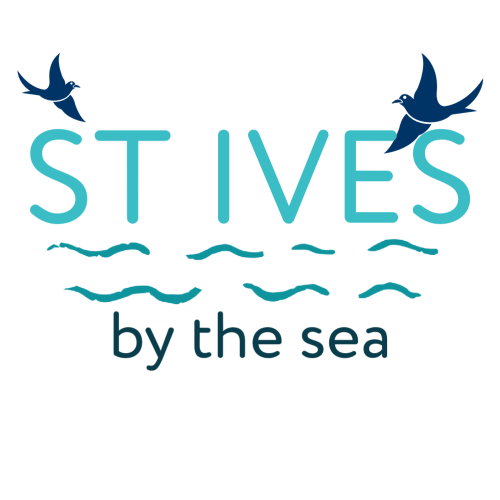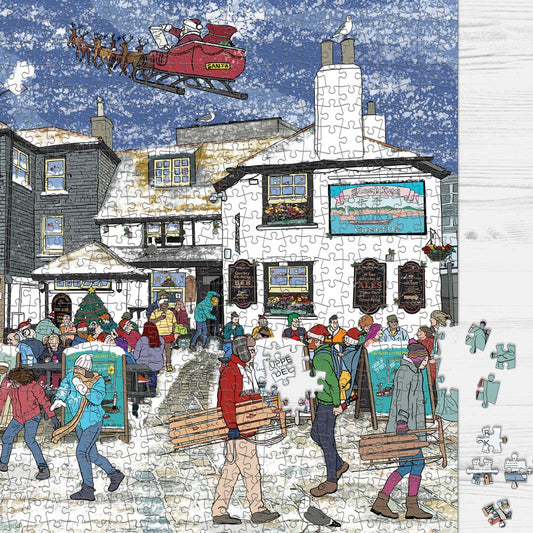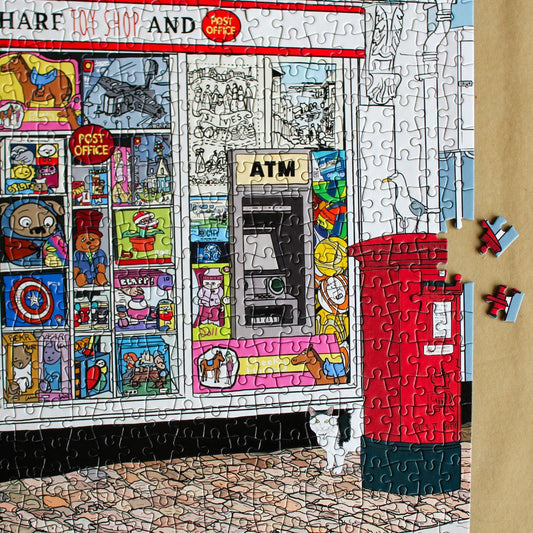St Ives has some of the loveliest and quirkiest road names I've ever come across.
Here are some of my favourites:
The Digey
The Digey is the road running from the middle of Fore Street (the main shopping street in St Ives) to Porthmeor Beach. It is one of the main streets in the Downalong area of St Ives and is packed full of character and charm.
Nearly everyone (including myself) pronounces The Digey incorrectly to being with. Most people say The Diggy, which is guaranteed to get a few raised eyebrows from the locals.
It is pronounced Dye-Gee (dye to rhyme with eye and gee and in gee up horsey!).
So What On Earth Does The Digey Mean?
The name is thought to have originated from "The Dye House" or Dye Chy. This is because the old building on the corner of Fore Street and The Digey used to be a "Dye House" where fishing nets were "dyed" or "barked". Chy is the name for house in Cornish - you will see lots of houses called Chy (including my own!).
Another origin of the name could be from the word "dyji", which means "small cottage" in the Cornish language. There are indeed lots of small cottages along The Digey!
There are several other ideas going around of where The Digey name originated. Some say about it being related to a farm house and meadow - but I can't find anything that links this to the name.
What ever The Digey's meaning, it is such an evocative name that instantly conjures up images of St Ives and all it's character.
Teetotal Street
Teetotal Street always raises a few smiles. It is a brilliant name for a street - and perfect to have on your mug of reviving tea after a night out in The Sloop!
Teetotal Street is a little road on the ladder of streets tucked away behind Back Road East on the way to The Island. It is know locally know as "The Rows". Teetotal Street was built in the 1800s but there is evidence of people living here all the way back to the medieval times.
So Why Is It Called Teetotal Street?
Teetotal Street is named, as you might well have guessed, after the temperance movement who were vigorous campaigners for not drinking alcohol. This was very popular in parts of St Ives in the 1800s.
The town was purported to have drinking problems and there was a huge concentration of drinking establishments in the town's harbour area. I believe at one stage there were more than 20 pubs crammed into the town. That is a lot of pubs for such a small population!
John Wesley came to preach Methodism in St Ives around this time and teetotalism took hold in a big way.
The town even had its own St Ives Teetotal Society, established in 1838. However, there is no record of any Teetotal Society meeting room having been erected around Teetotal Street.
Teetotal Street was built around the same time as all this was going on. The word teetotal was a new and fashionable word - and these were new houses! Maybe the builders, developers and town councillors were staunch teetotallers themselves?
Virgin St
Virgin Street to me always sounds a little risque! Virgin Street is the little street running left uphill at the fork of The Digey and Fore Street. It is cobbled and charming and car free! It is part of the Downalong area of St Ives and is full of quaint little fishing cottages, quirky signs and mermaids!
In the olden days Virgin Street would have been populated by the fishing community. Much of the processing of the fish took place here in cellars and courtyards that were part of the houses. The fish work took place on the ground floor, cellars and courtyards. People lived upstairs which is why you see lots of external steps leading to the second floor. This segregated the fish from the humans!
Why Is It Called Virgin Street?
Virgin Street is possibly named after St Ia The Virgin - of whom St Ives is named after. She was an Irish virgin Martyred at Hayle in the middle part of the 5th century.
Or it could have been called Virgin Street as in New Street.
Salubrious Terrace
Salubrious Terrace is an amazing sounding street. The name of it always makes me smile!
Salubrious Terrace is tucked away up Virgin Street, just off The Digey in the Downalong area of St Ives. (Now that is one of the most wonderful sentences I've ever written - each name is so evocative of St Ives!)
Why Is It Called Salubrious Terrace?
Salubrious, in terms of a place of residence means "pleasant, not too run down", although most of this area in the 1800s wouldn't have been the most salubrious place to live.
Most of the houses in the Downalong area were built for the fishing industry, with fish cellars and workings on the ground and lower floors, with residential occupation on the higher floors. Fish, rats, sewerage and rubbish would have been most unpleasant.
However, at the end of Salubrious Terrace is a very posh house called Salubrious House. It was built in 1812 for a ship's captain. Apparently, fishermen used to come to the garden each week to collect their money.
We don't know which came first, Salubrious Terrace or Salubrious House. What we do know is that it must have been known as a better or more "salubrious" area, as only the best would do for these flashy sea captains of the 1800s!
Interesting Fact
In the 1940s Salubrious House was known as a bit of a party house for the artistic community. Ben Nicholson lived next door and it was a popular place for late night parties. There are paintings of the view from Salubrious House by Ben Nicholson and Wilhelmina Barns-Graham.
Wheal Dream
Wheal Dream! Two words that conjure up both the harshness and ethereal nature of St Ives and Cornwall.
Wheal Dream is the little road tucked away above Bamaluz Beach. If you walk all the way along the quay, turn left past the Pier Coffee Shop and walk up toward the St Ives Museum, you will find Wheal Dream.
Why Is It Called Wheal Dream?
The reason for it's name is quite simple - it is named after the Wheal Dream mine, which is now where the St Ives Museum stands. You can still see bits of the old mine walls around Bamaluz Beach.
Wheal (whel or huel) means "mine" in the Cornish language. This was either a tin or a copper mine (i believe Wheal Dream was a copper mine) and they were all over St Ives. They are dotted all over St Ives in the most unlikely of places. If a road is called "Wheal" you can pretty much guarantee there used to be a mine there.
The Dream part I am struggling to find facts about on it's own. However, lots of mines are called Wheal Dream. Possibly because they are seen as a "golden venture" or amazing opportunity.
Sadly, the St Ives Wheal Dream was pretty unsuccessful and so the main building was soon turned into a store to cure and pack pilchards. This was in the mid 1800s. The building was then used as a religious meeting house, laundry and later a cinema. The upstairs however was used by the British Sailors Society Mission to house shipwrecked sailors who were waiting to be repatriated. This just show how treacherous being a sailor in the 1800s must have been!
Interesting Fact (if you like Troika pottery like I do!)
The Troika pottery was based at Wheal Dream from 1962 to 1970, (it then moved to Newlyn).
Fish St
You can't get more St Ives-y and harbour-y than Fish Street!
Fish Street is the road that leads from the harbour, past the side of The Sloop, towards The Island and Back Road West.
Why Is It Called Fish Street?
From the 1300s (when the harbour at Lelant silted up) right up to the early 1900s, fishing was a mainstay of the towns economy. The famous, lengthy sandy beaches provided a perfect landing place for the pilchard fishing industry - and there were enormous shoals of them in St Ives Bay.
The fishing fleet needed associated industries such as net and sail making and fish processing. Domestic fish processing was a big part of it all. So, buildings were built with fish cellars on the ground floor with residential accomodation above, reached by an external staircase.
Being so close to the harbour, Fish Street was one of the main fish processing streets - and named accordingly! You can still see lots of lovely old examples of the unusual fish cellar houses, although most of these have been turned into beautiful shops and holiday lets.
Interesting Fact (if you like old buildings!)
What is reputed to be the oldest house in St Ives is on Fish Street (number 5) It has a large chimney and is built from slately rubble stone. It is thought to date from the 17th century (1600s). It's basement is cut into the bedrock which must be fascinating to see! If you are feeling flash for cash you can rent it as a holiday home.
The Sloop Inn is on the corner of Fish Street and dates back to circa 1312 (just after St Ives had been granted a Charter by King Edward I).






